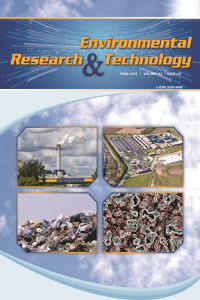Abstract
References
- [1]. A.B. Sharangi, “Medicinal and therapeutic potentialities of tea (Camellia sinensis L.)”, Food Research International, Vol.42, 529–535, 2009.[2]. K.P. Biswas, “Description of tea plant. In Encyclopaedia of Medicinal Plants”, New Dehli: Dominant Publishers and Distributors. pp. 964-966, 2006.[3]. F. Hoffmann, M. Manning, Herbal Medicine and Botanical Medical Fadsi New Yark: The Haworth Press pp. 202. 2005.[4]. A. Szymczycha-Madeja, M. Welna, & P. Pohl, “Elemental analysis of teas and their infusions by spectrometric methods”, Trends in Analytical Chemistry, Vol.35, 169–171, 2012.[5]. B.E Sumpio, A.C. Cordova, D.W. Berke-Schlessel, F. Qin, Q.H. Chen, “Green tea, the Asian Paradox, and cardiovascular disease”, J Am Coll Surg, 202, 813-820. 2006.[6]. M. Demeule, J. Michaud-Levesque, B. Annabi, D. Gingras, D. Boivin, J. Jodoin, et al. “Green tea catechins as novel antitumor and antiangiogenic compound”, Current Medicinal Chemistry & Anti-cancer Agents, Vol. 2, 441–63, 2002.[7]. F.K. Maiti, J. Chatterjee, S. Dasgupta, “Effect of green tea polyphenols on angiogenesis induced by angiogeninlike protein”, Biochemical and Biophysical Research Communications, Vol. 308, 64–, 2003.[8]. V.V. Chopade, A.A. Phatak, A.B. Upaganlawar, A.A. Tankar, “Green tea (Camellia sinensis): Chemistry, traditional, medicinal uses and its pharmacological activities- a review”, PHCOG Rev, Vol. 2, 157-162, 2008.[9]. P. Namita, M. Rawat, and J.V. Kumar, “Camellia Sinensis (Green Tea”, Global Journal of Pharmacology, Vol. 6, 52-59, 2012.[10]. S. Hsu, “Green tea and the ski”, J Am Acad Dermatol, Vol. 52, 1049e59, 2005.[11]. H.R. Kim, R. Rajaiah, Q.L. Wu, S.R. Satpute, M.T. Tan, J.E .Simon et al, “Green tea protects rats against autoimmune arthritis by modulating disease-related immune events”, J Nutr, Vol. 138, 2111e6, 2008. [12]. G. Park, B.S. Yoon, J.H. Moon, B. Kim, E.K. Jun, S. Oh et al. “Green tea polyphenol epigallocatechin-3-gallate suppresses collagen production and proliferation in keloid fibroblasts via inhibition of the STAT3-signaling pathway”, J Invest Dermatol, Vol. 128, 2429e41, 2008.[13]. S. Sarıca, Ü. Karatas, M. Diktas, “Çay (Camellia sinensis) İçerigi Metabolizma ve Saglık Üzerine Etkileri, Antioksidan Aktivitesi ve Etlik Piliç Karma Yemlerinde Kullanımı”, GOÜ Ziraat Fakültesi Dergisi, Vol. 25, 79-85, 2008. [14]. I.A. Ross, “Tea common names and its uses”. In Medicinal Plants of the World. 3 rd Vol. New Jersey: Humana Press. pp. 1-19. 2005.[15]. M.X. Doss, S.P. Potta, J. Hescheler, A. Sachinidis, “Trapping of growth factors by catechins: a possible therapeutical target for prevention of proliferative diseases”, J Nutr Biochem, Vol. 16, 259–266, 2005.
Abstract
Camellia sinensis, which is widely used as a beverage in our country
and in the world, has various beneficial effects on human health due to its
various components. Farmers use chemical fertilizers to get more products.
However, the use of more chemical manure may cause some problems in terms of
environmental pollution and human health. Due to the lack of some nutritious
minerals in the soil, various manure ingredients are used for better
cultivation and growth. In this study, in order to investigate the effect of
use of manurate on tea plant on 5 different soils in Rize, the concentrations
of 18 elements in the leaves were analyzed using the ICP-MS device. When manure was used in tea, the
concentration of Li, Mg, K, Al, Ca, Cr, Mn, Fe, Cu, Zn, As, Se, Cd, Pb elements
increased and Na, Co, Ni, Hg values decreased.
References
- [1]. A.B. Sharangi, “Medicinal and therapeutic potentialities of tea (Camellia sinensis L.)”, Food Research International, Vol.42, 529–535, 2009.[2]. K.P. Biswas, “Description of tea plant. In Encyclopaedia of Medicinal Plants”, New Dehli: Dominant Publishers and Distributors. pp. 964-966, 2006.[3]. F. Hoffmann, M. Manning, Herbal Medicine and Botanical Medical Fadsi New Yark: The Haworth Press pp. 202. 2005.[4]. A. Szymczycha-Madeja, M. Welna, & P. Pohl, “Elemental analysis of teas and their infusions by spectrometric methods”, Trends in Analytical Chemistry, Vol.35, 169–171, 2012.[5]. B.E Sumpio, A.C. Cordova, D.W. Berke-Schlessel, F. Qin, Q.H. Chen, “Green tea, the Asian Paradox, and cardiovascular disease”, J Am Coll Surg, 202, 813-820. 2006.[6]. M. Demeule, J. Michaud-Levesque, B. Annabi, D. Gingras, D. Boivin, J. Jodoin, et al. “Green tea catechins as novel antitumor and antiangiogenic compound”, Current Medicinal Chemistry & Anti-cancer Agents, Vol. 2, 441–63, 2002.[7]. F.K. Maiti, J. Chatterjee, S. Dasgupta, “Effect of green tea polyphenols on angiogenesis induced by angiogeninlike protein”, Biochemical and Biophysical Research Communications, Vol. 308, 64–, 2003.[8]. V.V. Chopade, A.A. Phatak, A.B. Upaganlawar, A.A. Tankar, “Green tea (Camellia sinensis): Chemistry, traditional, medicinal uses and its pharmacological activities- a review”, PHCOG Rev, Vol. 2, 157-162, 2008.[9]. P. Namita, M. Rawat, and J.V. Kumar, “Camellia Sinensis (Green Tea”, Global Journal of Pharmacology, Vol. 6, 52-59, 2012.[10]. S. Hsu, “Green tea and the ski”, J Am Acad Dermatol, Vol. 52, 1049e59, 2005.[11]. H.R. Kim, R. Rajaiah, Q.L. Wu, S.R. Satpute, M.T. Tan, J.E .Simon et al, “Green tea protects rats against autoimmune arthritis by modulating disease-related immune events”, J Nutr, Vol. 138, 2111e6, 2008. [12]. G. Park, B.S. Yoon, J.H. Moon, B. Kim, E.K. Jun, S. Oh et al. “Green tea polyphenol epigallocatechin-3-gallate suppresses collagen production and proliferation in keloid fibroblasts via inhibition of the STAT3-signaling pathway”, J Invest Dermatol, Vol. 128, 2429e41, 2008.[13]. S. Sarıca, Ü. Karatas, M. Diktas, “Çay (Camellia sinensis) İçerigi Metabolizma ve Saglık Üzerine Etkileri, Antioksidan Aktivitesi ve Etlik Piliç Karma Yemlerinde Kullanımı”, GOÜ Ziraat Fakültesi Dergisi, Vol. 25, 79-85, 2008. [14]. I.A. Ross, “Tea common names and its uses”. In Medicinal Plants of the World. 3 rd Vol. New Jersey: Humana Press. pp. 1-19. 2005.[15]. M.X. Doss, S.P. Potta, J. Hescheler, A. Sachinidis, “Trapping of growth factors by catechins: a possible therapeutical target for prevention of proliferative diseases”, J Nutr Biochem, Vol. 16, 259–266, 2005.
Details
| Primary Language | English |
|---|---|
| Subjects | Environmental Engineering |
| Journal Section | Research Articles |
| Authors | |
| Publication Date | June 30, 2019 |
| Submission Date | December 11, 2018 |
| Acceptance Date | April 28, 2019 |
| Published in Issue | Year 2019 Volume: 2 Issue: 2 |


